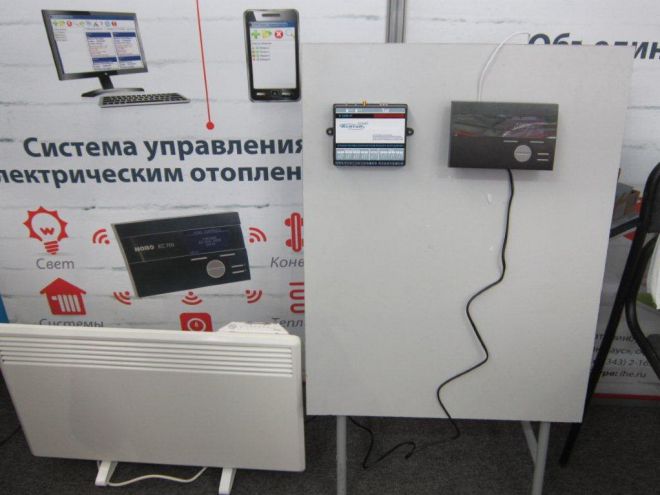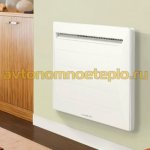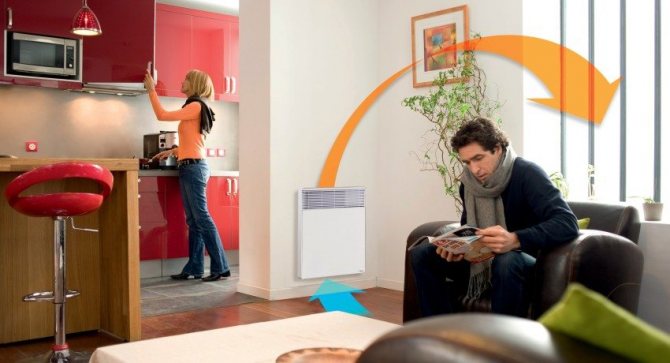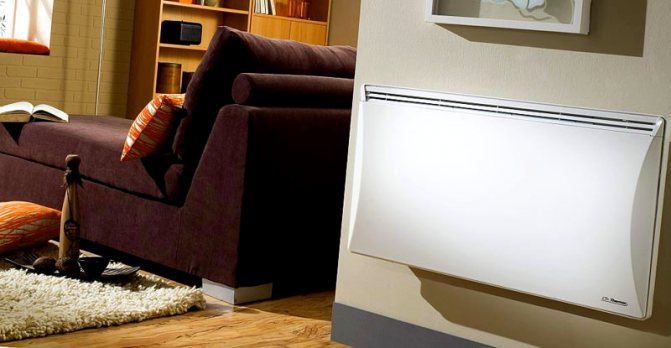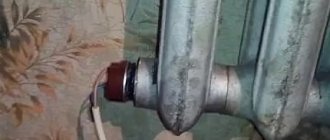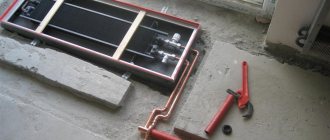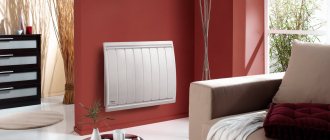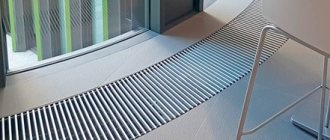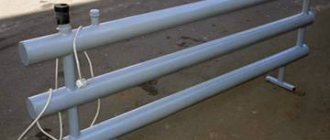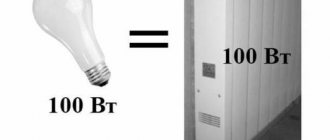Choosing the best electric convector, how not to make a mistake when buying
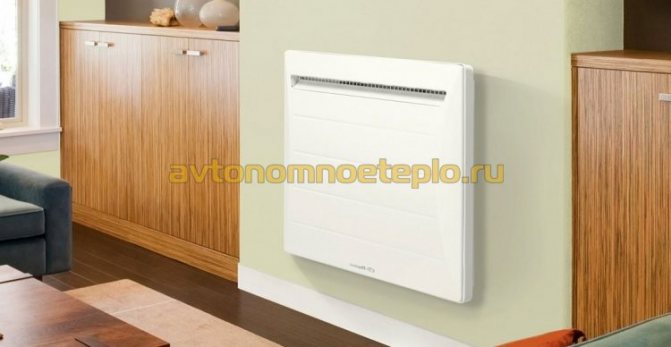
Electric convectors are especially popular. The capacity of the installations is sufficient to heat an apartment or a private house. Considering that there are several dozen different modifications on the equipment market, the question of which electric convector is better is asked by almost every buyer of climate technology.
How does an electric convector work
In this regard, the question arises, an electric convector - what is it? This is a device using the principle of convection of air masses. The air heated with the heating element rises upward. After cooling down, it goes down and again falls into the heating block of the device.
To ensure continuous convection, air ducts are provided in the housing through which air is drawn in and out.
The principle of operation of the electric convector may differ slightly depending on the type of heating element used and the presence or absence of pressure equipment (fan).


Principle of operation
From school physics lessons, we all remember very well that warm air rises up, and cold air tends to go down. Heating of premises is carried out by analogy. To understand: how convector heating works, you first need to figure out what the heating convector itself is. Simply put, it is a wide tube, along the vector of which metal plates are attached. Inside the pipe there is a special coolant that heats up all the parts of the device.


Electric convector device
The convector's principle of operation is that the plates constantly heat the incoming air. Due to this, heat is circulated throughout the room. As a result, we get a well-heated room.
Types of electric convectors heating
When choosing climatic technology, it is important to take into account that electric convectors may differ from each other in the following characteristics:
- Mounting type.
- The heating element used.
You should also pay attention to the manufacturer of the product and the cost of electricity.
Types of electric convectors, according to installation features
Air convection heaters can be divided into three categories.
- Wall mounted. Wall-mounted convectors are the most efficient. The location on the wall facilitates the convection process and increases the efficiency and heat transfer of the heaters.
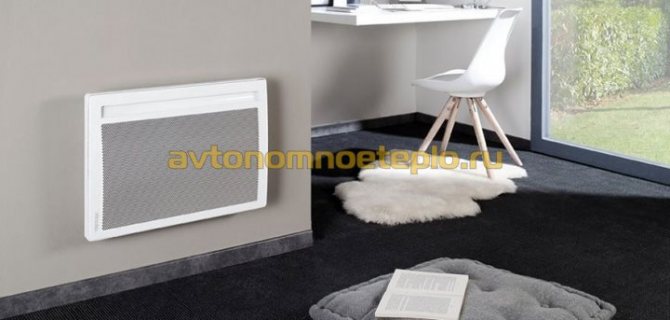

Floor-standing version - used as an additional source of heat. Models with a built-in fan differ in performance. The convector with forced air circulation cannot boast of quiet operation, but it warms up the air well.


Classification of convectors according to the heating element used
Which company is the best electric convector to choose
After evaluating the pros and cons of the equipment offered to the domestic consumer, a small rating of convectors was compiled.
- The best option is Noirot Melodie Evolution - a new generation, premium class electric wall-mounted heating convector. Has a waterproof design, is mounted on the wall. With a monolithic heating element, which ensures almost silent operation of the device. Ease of control Noirot Melodie Evolution provides a touch panel or LED display (depending on the model).The programmer has several built-in operating modes and the ability to create your own heating schedule. A model with a remote control function is available for purchase. With the help of Noirot Melodie Evolution and a GSM alert system, heating a summer house or a country house with electric convectors has become completely safe and comfortable.


The middle class is Electrolux equipment. The company offers the consumer household wall-mounted electric heating convectors with a thermostat. Most Electrolux models are universal and can be installed on the floor at the request of the customer. It should be borne in mind that this will slightly reduce the performance of the device. A tubular or monolithic heating element is used as a heating element.


The budget version includes Ballu, Resanta convectors and other Russian-made equipment. The domestic manufacturer has set up the production of equipment with electronic control, a high degree of reliability and protection. The cost of equipment due to assembly at factories in Russia has been reduced by 1.5-2 times.


The best electric convectors for the home
There are many manufacturers of heating household equipment and the market is expanding every year, so for the layman, the question of which electric heating convector is better always remains relevant. At the top of the latest ratings are the brands Ballu, Noirot, Atlantic, Hyundai, Timberk TEC. While some firms produce expensive goods, attracting customers with the highest quality and the latest technologies, other companies bribe with affordable prices, confidently leading in the middle price segment.
Electric convector Ballu
Ballu is a large corporation specializing in the production of modern heating and air conditioning systems with factories in China, Korea, Russia and Japan. The heating of the house with the Ballu Plaza BEP / E-1000 electric convector, which looks more like a stylish plasma panel, rather than a standard floor heater, deserves excellent reviews. The advantages of the model are the facade made of black high-strength glass, the presence of a remote control, the absence of noise, a high-quality aluminum heater, and a digital sensor.
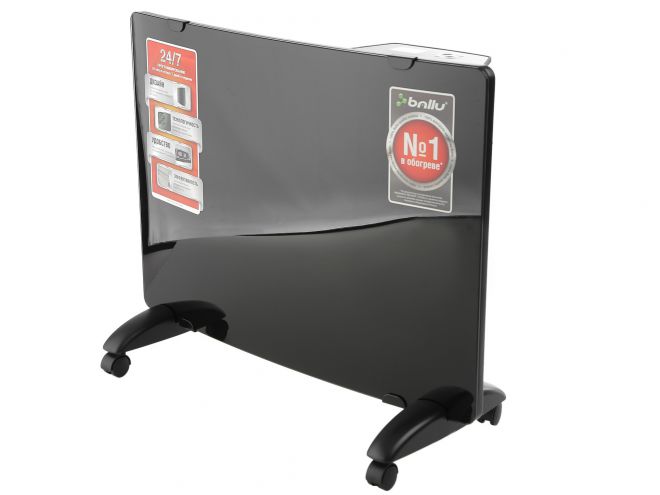

Electric convectors Noirot
The Noirot company principally manufactures all products at its own factories located in the French city of Lahn, any heater from this brand meets the highest international standards. If you are at a loss in the question of how best to choose an electric convector for your home, which brand is better, then feel free to purchase a Noirot heater. The reliable and economical heaters of the NOIROT SPOT E 3 series, with a lifetime guarantee, 90% efficiency, IP 24 protection class and a huge number of settings, deserve recommendations.


Electric convectors Atlantic
In the case when you are limited in funds and have not yet decided which electric convector to choose, then pay attention to the products of the Atlantic brand. It can be classified as inexpensive, but well-assembled goods that can last for many years without breakdown. For example, the Atlantic Bonjour 1000W heater costs 2.5 times cheaper than Ballu or Timberk devices, but it does not dry the air, boasts a good waterproof case, overheating protection, precise adjustments, and quiet operation.
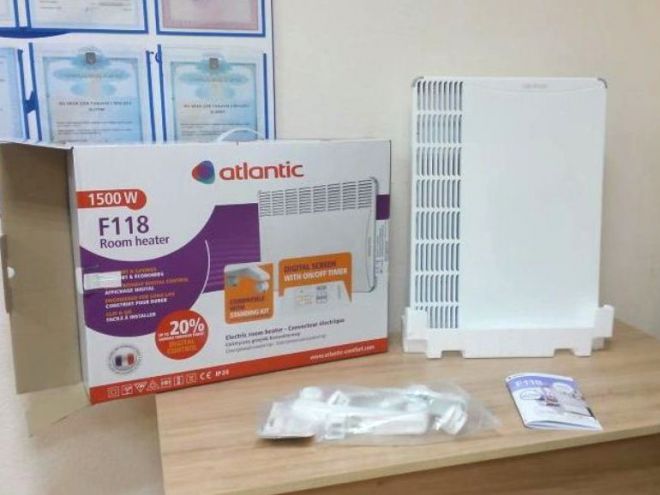

Convectors electric Hyundai
This company does not need special advertising, its products are famous for their durability, quality, and reasonable prices. Any electric convector manufactured by Hyundai is equipped with a high-quality heating element that can serve up to 20 years, dust protection and moisture protection of all heaters at the IP 24 level. In emergency situations, the automation instantly turns off the power and prevents the heating element from burning out. Owners of large apartments with an area of up to 24 m2 should take a closer look at the powerful, stable and compact device of the mid-price range Hyundai H-HV14-20-UI540.
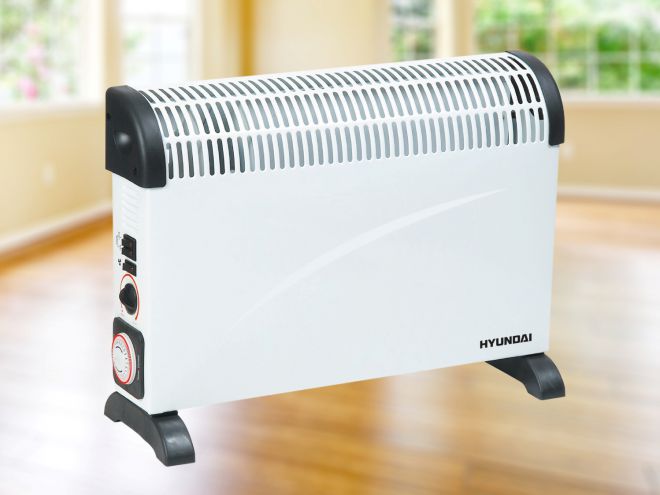

Electric convectors Timberk TEC
Timberk TEC heaters are interesting and practical, equipped with many of the latest innovations available at the moment.Choosing the best electric convectors for heating a summer cottage, you can take a closer look at the light and affordable Timberk TEC.E0 M 1500 model. Its outer casing does not heat up above 65 ° C at any thermostat setting. If the device falls and turns over, the sensor will instantly turn off. The universal mount allows the portable floor heater to be converted into a stationary wall-mounted convector.
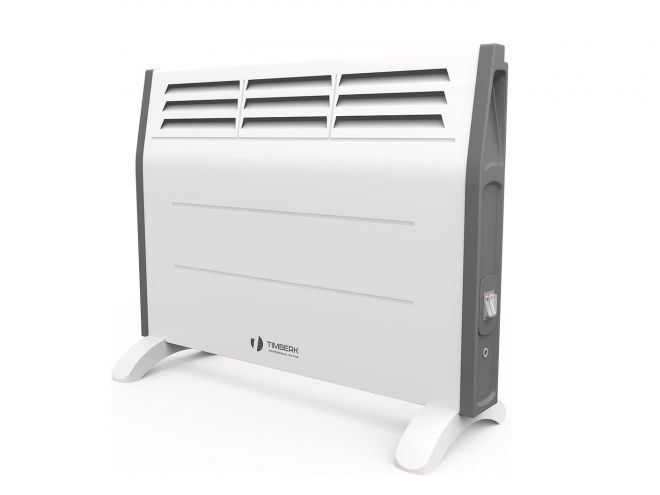

How to calculate and choose an electric convector
In fact, choosing a convector on your own is not so difficult. It is enough to take into account a few important aspects and make simple calculations.
We calculate the required power of the convector
During the calculations, several important nuances must be taken into account:
- Calculation of the convector's power by the area of the room. Provided that the room is well insulated and has a ceiling height of no more than 2.7 m, 1 kW of thermal energy will be sufficient for every 10 m² of heated area. For a bathroom of 6 m², one heater per 1 kW should be enough. Bedroom 20 m² - convector with a capacity of 2 kW.
- Number of windows. The principle of operation of devices is associated with the use of convection, this in a certain way makes its own adjustments to the choice of heaters. The total heat energy required to heat a room should be divided by the number of window openings. So, for a room of 20 m² and having two windows, you will need to install 2 heaters of 1 kW each.
- The presence of heat loss. The technical characteristics of electric convectors given in the operating instructions of the device, in particular, the coefficient of the heated area, are taken taking into account the absence of significant heat losses in the room. If you have a non-insulated basement, walls of the house, you should choose a heater with a sufficient power reserve.
To figure out how to choose the right electric convectors for heating, in addition to the power of the device, it is necessary to take into account also the technical characteristics and functionality of the device.
Choosing an electric convector by functionality
How much electricity does the convector consume?
For convenience, the calculation of electricity consumption is made for permanent residence in a house with a heated area of 80 m².


The total power of convectors for the house will be 8000 watts.- Taking into account that the convector will not work in a constant mode, and when a certain temperature in the room is reached, it will be switched off, conventionally we take a coefficient of 60% as the electricity consumption per day.
- We calculate the cost of electricity per hour 8000 W × 60% = 4.8 kW per hour.
- Electricity consumption per day. Provided that an electronic or programmable thermostat is working, the heater will work during the day for no more than 12 hours. 4.8 × 12 = 57.6 kW / day.
- 1728 kW will be consumed per month.
The result obtained may differ depending on the type of heater used, heat loss in the house and other parameters.
Does the electric convector dry the air?
A slight decrease in moisture is observed when using a fan. This is especially noticeable if the heaters are operated continuously. Compared to heat guns, the convector does not dry the air at all.


As an additional measure to maintain a healthy microclimate, it makes sense to supply an air humidifier complete with an ionizer, or purchase a modification of the heater with a built-in device of this type. The control system itself will automatically monitor the humidity level and maintain it at the proper level.
Which is better, an electric convector or a fan heater
The fan heater heats the air instantly, passing it through a red-hot spiral. As a result, moisture evaporates and air dries out.It makes sense to use a fan heater where it is necessary to quickly warm up the room. It is not recommended to install such heaters as the main source of heating.
Unlike a fan heater, convectors operate in a safer mode. Thanks to this, you can even hang electric convectors on a wooden wall. The surface temperature of the case rarely exceeds 60 ° C.
Of course, you should follow the rules for installing electric convectors in a wooden house:
- The electrical wire is laid on top of wooden surfaces in a special fire-resistant corrugation.
- Foil-coated thermal insulation is placed under the wall-mounted heater.
- Floor electric heating convectors for wooden cottages are installed in such a way that the nearest wall is at least 0.5 m. There is no need to put non-combustible material under the heater.
Time has shown that the best solution is to install an electric convector. Although the device heats up more slowly than the fan heater, it provides complete operational safety, protection from fire, and also has a beneficial effect on the microclimate in a country house or summer cottage.
Varieties of convector heating
There are the following types of convector heating systems:
- Gas. Gas-fired heating devices are used to heat the premises. At the same time, heating of a frame house or buildings made of other materials can be organized using balloon or main fuel.
- Electrical. There are heaters inside the device that heat up when the unit is connected to the AC mains.
- Water. These are units with pipes, inside of which a heated liquid heat carrier moves. It can be water or antifreeze. Such devices are connected to centralized heating networks or installed in an autonomous system of a private house.
Each type of convector heating has its own characteristics, pros and cons. Let's consider them in more detail.
Gas convectors


These units operate using main or liquefied gas from cylinders or gas tanks. To connect to the centralized gas main, you must obtain a permit from the gas service. You do not need to obtain a permit to use bottled gas.
Gas convector working principle:
Electric heating elements with a thermostat for heating boilers and batteries
- Inside the appliance there is a combustion chamber in which there is a gas burner. Here the gas-air mixture burns with the release of a large amount of heat.
- This heat energy heats up the body of the device. As a result, the walls of the unit give off heat to the air. When the air heats up, the principle of convection starts to work. In other words, warm and cold air masses begin to circulate in the room.
Gas convectors are not popular because they are large in size, do not provide an adequate level of fire safety, and their connection is rather complicated and time consuming. Also, the disadvantage is the need to remove combustion products that are formed as a result of fuel combustion.
Important! Gas convectors are equipped with a coaxial chimney, so a hole has to be made in the wall next to the unit to bring the pipe outside the house.
Water convectors
Traditionally, water convectors are used in residential private houses and apartment buildings. For the operation of these heating devices, it is necessary to lay pipelines with a circulating coolant, connect radiators to them.
Water or antifreeze can be used as a heat carrier. To heat the coolant in autonomous systems, a boiler is installed that runs on solid fuel, electricity or gas. The choice of the type of fuel is made taking into account the resources available in the region.
The heated coolant gets into the devices connected to the heating circuit. Heat from it is transferred to the steel surfaces of the convector. The air in contact with the heated radiator is also heated and begins to circulate in the room.
To make it more convenient to regulate the temperature in the room, control valves and thermostats are installed on each heater. In autonomous systems, you can regulate the temperature of the coolant. On water convectors, Mayevsky taps are sometimes installed to release air.
Important! Heating a frame house with water convectors ensures the proper degree of fire safety.
Electric convectors
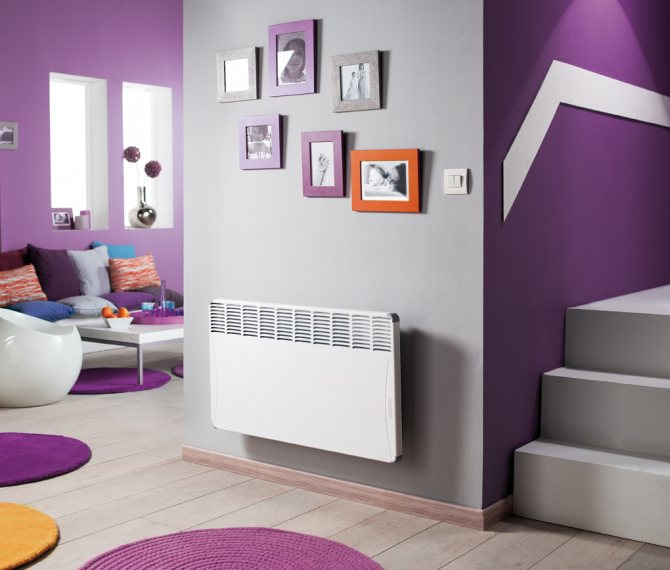

Convection electric heating is easy to install and easy to use. To organize such heating, you need to purchase an electric convector, connect it to the mains. The device can be hung on a wall using brackets or installed on the floor.
Pluses of electric convectors:
Gas heating convectors for home and their device
- Installation and connection of the device is carried out in a matter of minutes. You can do everything yourself.
- There is no coolant inside the unit, therefore corrosion, freezing or leakage are not threatened.
- Most electric convectors are mobile devices, so they can be installed anywhere and, if necessary, moved to another room.
- Thanks to mechanical or electronic control, the required temperature can be maintained in the room.
- Devices with a built-in thermostat automatically turn off when the desired room temperature is reached and turn on again when the temperature drops below the set threshold.
Important! Electric convectors with a built-in thermostat save up to 10% of energy.
The disadvantages of electric convectors are the high cost of the energy carrier, so electric heating of even a small house will result in a large amount.
The best convectors
One of the most common heating devices is a convector that runs on electricity or gas. Such a heat source is called highly efficient because it quickly heats up the air, does not take up much space, is quite reliable and can be equipped with additional functions. This ranking contains reviews of the best convectors of 2020. The experts provided useful information on the choice of models, and also pointed out the advantages and disadvantages of the devices.


Which company convector is better to choose
Companies producing convectors, as a rule, are engaged in narrowly focused activities - the production of heating devices. Surveys show that users prefer reliable, trusted firms that have a lot of positive reviews and a decent reputation. For review, brief characteristics were collected for each trademark:
- Noirot spot - a brand from France that produces heaters, manufactures and develops them only at its own enterprises, importing heat sources to more than 90 countries.
- Stiebel Eltron Is a brand from Germany that manufactures electric heating equipment. It has many subsidiaries in the territories of Asian and European countries, is a sponsor of sports and charitable events, and is one of the market leaders in the field of heating.
- Electrolux - a popular company from Sweden that produces household appliances for the home, produces climatic and professional equipment. The company's products belong to the middle and low price segment.
- Timberk Is another large corporation from Sweden that produces climatic equipment.It focuses on the production of a wide range of products, from simple water heaters to functional split systems.
- Resanta Is a Latvian brand that manufactures electrical goods. Offers a large selection of convectors, heaters, voltage stabilizers at average prices. Every year the company participates in international exhibitions, where it presents its own developments.
- Hyundai - a large holding from South Korea that manufactures consumer electronics. In creating its products, the company uses only modern innovative systems aimed at making the use of goods more comfortable.
- Ballu Is a Russian trade mark that produces HVAC equipment for industrial and domestic purposes. It has production facilities not only in Russia, but also in China, uses only high-quality raw materials.
- Scoole - a manufacturer from Russia, produces climatic equipment for the home, offering a large range of air conditioners, split systems, fans. It sells goods on the territory of the Russian Federation and the CIS countries, in compliance with strict international quality standards.
- Power KVZ Is another Russian company producing climatic equipment. In production, components of well-known brands are used, which ensure the reliability, safety, and quality of devices.
- Varmann - the largest trade mark producing convectors, heat exchangers, facade heating systems. It sells goods to Russian and European markets, gives long warranty periods for all products, accepting orders for individual projects.
- KZTO Breeze - a plant for the production of heating equipment, for 20 years has been occupying a leading position among Russian manufacturers. The advantages of the company include reliability, style, reasonable price for premium goods.
- iTermic ITTZ - a trademark of the Rada-M company, which produces heating devices. It manufactures premium class products, provides long-term guarantees, and uses high-quality raw materials in production.
Convectors rating
When compiling the rating, reviews of real people and the opinions of experts who selected the nominees were taken as a basis. Also, testing was carried out, which helped to identify the advantages and disadvantages of thermal equipment. When selecting participants in the TOP, the following criteria were taken into account:
- Device type;
- Quality of materials;
- Security;
- Thermal power;
- Heat source;
- Heating area;
- Installation method;
- Thermostat;
- Price.
Analyzing the listed properties and conducting thorough tests, experts have selected the best convectors from the 2020 models. Another condition for entering the TOP was the ratio of price and quality.
Analysis and rating of the best electric convectors for summer cottages and houses
Providing an optimal microclimate at home or at work is a very important task. The required air temperature in the room provides comfortable conditions for both work and rest. But choosing a heater is not easy. This is due to the variety of models on the market. The right approach to evaluating equipment guarantees a purchase that you won't have to regret. To find the best convectors for your home or office, you need to outline the main criteria for choosing a device.
Additional functions of convectors
Modern electric convectors are not limited to simply heating the air. Many of them have additional features that make the atmosphere in the house even more comfortable:
- anti-freezing function - the convector switches on automatically if the air temperature in the room drops below 5 degrees Celsius;
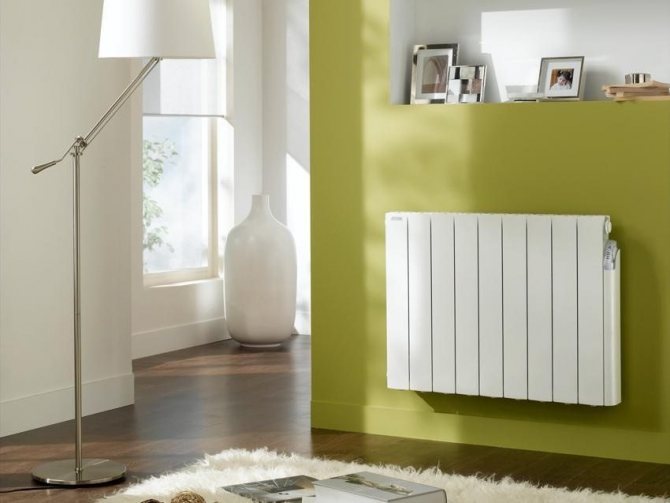

The compact convector silently heats the air in the room
- different modes of operation - many heaters work not only in the basic mode, but also with the settings "comfort", "economy", etc .;
- air ionization is a very useful function that can work even when the heating element is off;
- rollover sensor - automatically turns off the convector if it falls. A useful function if there are animals or small children in the house;
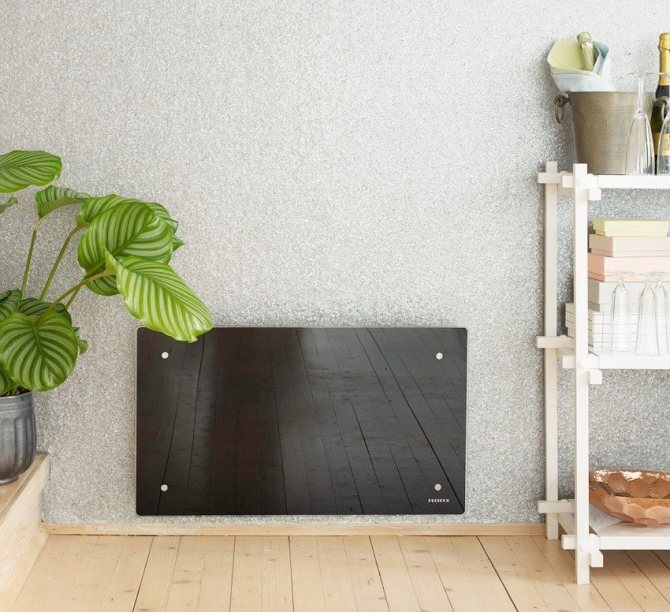

Glass ceramic panel heats the air and creates natural convection
- automatic memorization of parameters - when turned off, the electronics remembers the set settings and returns to them after turning on;
- programmable heating element - with its help you can set such fine settings as hourly temperature change, temperature for the night or for the day, and even for a certain day of the week;
- universal control module - makes it possible to simultaneously configure several convectors located in different rooms from one control panel. A great option for a large house.
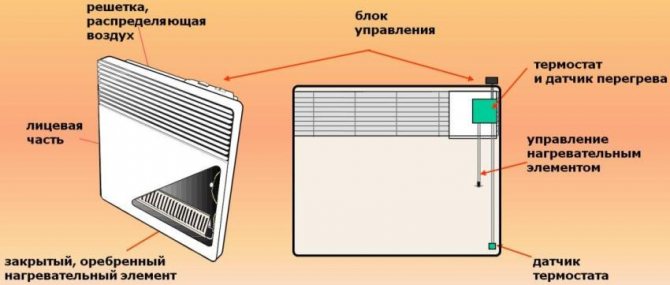

Constructive elements of the electric convector
Working principle and classification
The design of the device for generating heat is quite simple: housing, air ducts, heating element, equipment for connection. The principle of operation is also not difficult: cold air from the environment enters the device. With the help of additional devices, it heats up and is released through the opening at the top of the device.
To conserve energy and maintain an optimal temperature, space heaters are equipped with temperature sensors. The main advantage of convectors over similar heat sources is safety. The temperature on the device body does not exceed + 60 ° C.
In this video, you will learn how to choose a heater:
Convector classification:
- by mode of action (water, electric, gas);
- by type of fastening (floor, wall, universal);
- according to the design of the heating element (monolith, heating element, needle).
Water convectors are suitable for installation in both autonomous and central heating systems. It is impractical to place them in rooms with high wall heights. With forced air circulation in the room, the operation of the device will be ineffective.
The advantage of gas convectors in comparison with water heaters is the independence of operation from low temperatures. The disadvantages include the significant dimensions of the installations, increased explosiveness. The best choice for heating apartments and summer cottages is electric convectors.
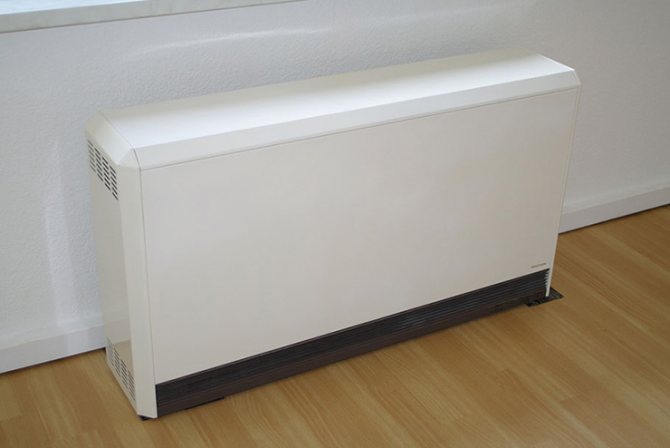

Convectors differ, at least in the way of fastening
What is an electric convector: basic definitions
Heating devices of this category are installed in residential and office premises. They attract potential consumers with low cost, compact size, low weight. All the advantages and disadvantages in comparison with the alternatives will be discussed below. However, in addition to the democratic price, it should be noted the high efficiency, which in modern models is very close to the ideal value of 100%.
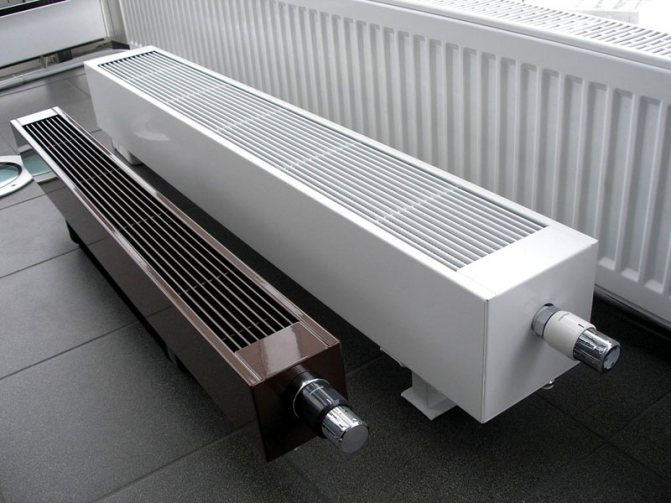

The neutral look of typical floor and wall mounted electric heating radiators suits a variety of styles
In the process of studying different market offers, in addition to choosing aesthetic parameters, it will be necessary to decide what power the device is suitable for heating certain rooms. The required heating capacity should be calculated with a small margin so as not to experience difficulties in severe frost. Make sure that the local wiring and connection conditions to the public networks match the overall needs. It will not hurt to check your own installation skills. If independent work is not possible, the knowledge gained from this article will help control the actions of hired specialists.
Main characteristics
Since a convector is a thing that is bought for long-term use, you need to approach the purchase responsibly. Heaters are evaluated for different characteristics.You can quickly navigate when choosing a device by highlighting its most important parameters.
Indicators to pay attention to before buying:
- method of fixing the device;
- power consumption;
- type of thermostat;
- type of heater;
- security.
By arrangement, convectors are wall-mounted, floor-standing and universal. When purchasing a wall heater, it is necessary to clarify whether the fixture parts are supplied with the device. Some models do not have them, they have to be purchased separately. The advantage of this type of convectors is in saving space: they do not take up additional space in the room, which is essential for rooms and apartments with a small area.
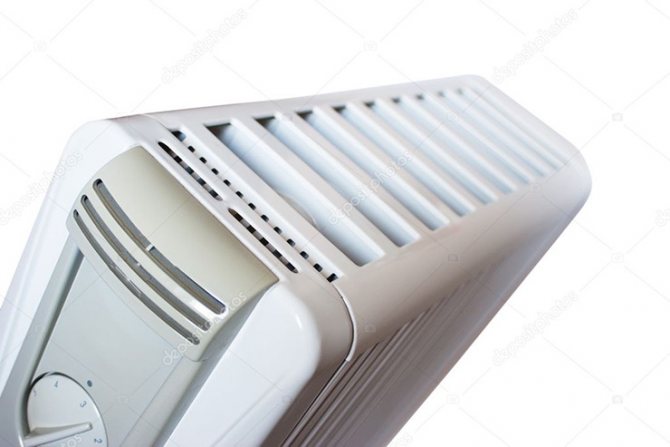

Do not forget to look at the power consumption of the convector when buying it
Floor heaters are equipped with feet or castors. Their advantage is mobility. By moving them, you can achieve the required temperature in all hard-to-reach areas of the room.
The most practical are convectors of a universal type. They can be installed on the floor or hung on the wall. When buying, you should check the presence of wheels or legs in the package: sometimes you have to buy them separately.
One of the decisive factors when choosing a heater is its capacity. If you bought a device with an underestimated value, it will not be possible to achieve the optimal temperature in the room. Overpowering is a guarantee of an inexpediently high cost of the device.
It is necessary to take into account the purpose of the convector (single heat source or auxiliary). If it is needed in an apartment as an additional heater, then one kilowatt of device power will be enough for a room with an area of 20 square meters. In the absence of main heating, you should choose equipment for a microclimate with a high power value.
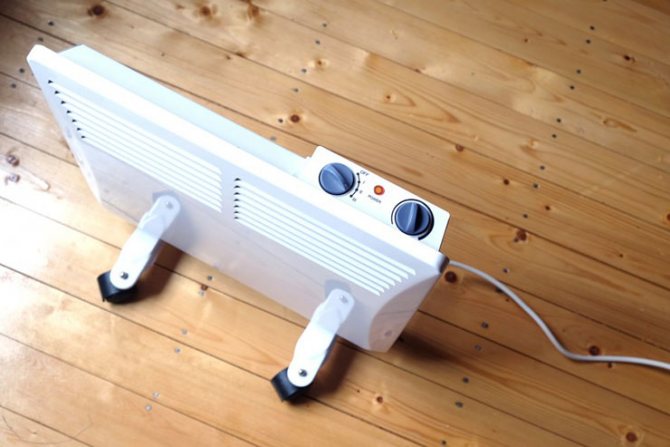

Will the convector be an additional heater or a main heater?
Convector thermostats can be of two types:
Electric convectors - characteristics
Inexperienced users pay main attention to the design of the electric heating convector and the brand of the manufacturer, neglecting the technical characteristics. This approach always subsequently threatens with big problems during its operation. For example, even a high-quality device from a well-known brand will not be able to heat more area than the power of its heating element allows.
The main characteristics of the electric convector:
- Electric convector power
- 1 kW is approximately enough to heat a room up to 12 m2. - Dimensions (edit)
- Before purchasing, make accurate measurements of the place where you plan to install the heater. Powerful devices have a large front panel thickness and area. For example, a high-quality 2 kW electric convector with the same height will be almost three times longer than a 500 W heater. - Waterproof
- for swimming pools, bathrooms and kitchens, it is better to buy air heaters with splash protection, approved for operation at high humidity. Well-known manufacturers always indicate this characteristic in the passport data.
Additional functions
In convectors with electronic control, manufacturers offer a number of additional modes. Before buying, you should make sure that they are really necessary. The anti-freeze function will allow you to keep the minimum temperature in the room within + 5 ... + 7 ° C in the absence of the owners. At the same time, the bill for the consumed energy is small, since an empty dwelling will not overheat in vain.
Programming the operating modes allows you to set the necessary parameters at different times of the day, which will significantly save energy resources and the payment for them.
The remote control function facilitates the operation of the device for disabled and elderly people.Air ionization is useful for people who have to stay indoors for a long time, as well as for asthmatics and allergy sufferers.
It should be borne in mind that auxiliary functions provide additional comfort when using the device, but at the same time increase its cost.
Schematic diagram of the device and the operation of an electric convector
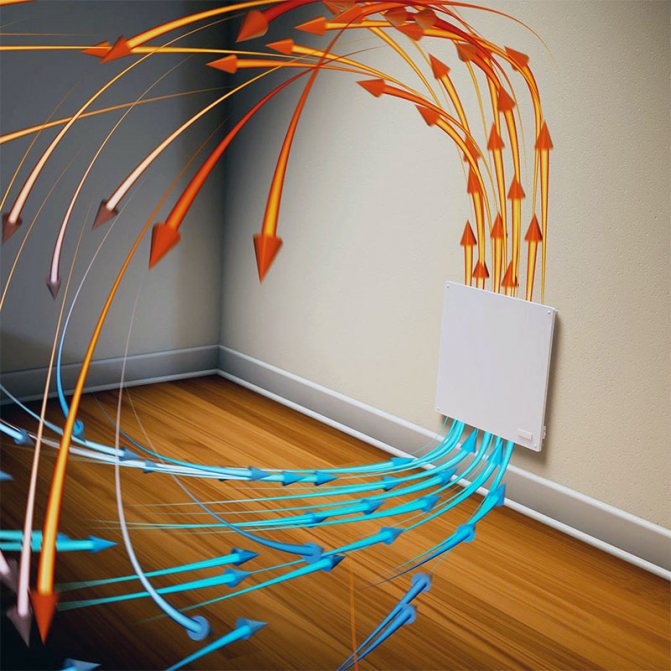

This is how the air flows
With the help of this figure, it is easy to understand the principle of operation of the technique of this category. Cold air is heated by a heat exchanger and rises to the ceiling. The process is repeated until the set temperature is reached.
The main features of the wall-mounted electric convector with a thermostat should be emphasized. Unlike a standard radiator, heating takes place inside the case. The temperature of the outer walls is maintained between + 40 ° C and + 60 ° C. This allows you to maintain a high level of security without additional measures. However, the air in the room will gradually warm up from top to bottom. This method can slow down the process excessively in a room with a high ceiling.


Main components of a modern convector with electronic thermostat
The following functional elements are marked in the figure:
Electric convectors rating
The most popular are heating devices that consume electrical energy. This is not surprising since There are quite a few advantages of this type of heater:
- ensuring the same temperature at all points in the room;
- noiselessness;
- work without accumulation of dust and unpleasant odors;
- during operation, humidity does not decrease, since oxygen is not burned;
- high heating rate;
- energy saving;
- small dimensions;
- ease of use and reliability.
There is no definite answer to the question of which electric convector is better. Products of such well-known brands as Noirot, Neoclima, Electrolux, Ballu, Timberk have been tested by many users and time. Therefore, the models of these companies often occupy first places in the ratings of the best electric convectors. Every day new manufacturers of microclimate household appliances appear on the market. The cost of the products they offer is slightly less due to the unknown, but it is difficult to judge their quality and level of reliability.
Electric convectors of the new generation are distinguished by their stylish appearance, the presence of a liquid crystal display, and an energy-saving mode of operation. In order to objectively assess a certain heating equipment, the place of its installation should be taken into account.
Household microclimate devices
For a dwelling with an autonomous heating system, in which people are constantly located, convectors select low power, since they mainly serve as additional sources of heat.
Top 5 best electric convectors for home heating.
Electric convectors for home
In recent years, the previously popular oil radiators and fan heaters are increasingly being replaced by electric heating convectors. They are not without drawbacks, but due to the original heating principle, they surpass competitors in technical characteristics in many aspects. If the operation of oil batteries is based on the principle of radiation, then here the heating is carried out due to the circulation of air masses, which significantly accelerates the process of uniform distribution of heat in the room.
The advantages of an electric convector:
- The ability to accurately regulate the room temperature.
- Installation work is carried out with ease without the involvement of specialists.
- The heating elements of the convector are made of heat-resistant alloys, they are durable and warm up quickly.
- The standard electric convector is made in the form of a compact rectangular flat panel that takes up little space in the room.
- During operation, the convectors make little noise, comparing favorably with most of the old-type fan heaters.
- Electric convectors can be mobile and stationary, which significantly expands the scope of their use in everyday life.
- Low price compared to boilers.
- No need to draw up special documents when connecting.
- Using a built-in radiator allows you to get heat without burning oxygen.
- The best models come with useful extras - precision thermostats with remote control, power indicators, built-in fans, off timers, humidifiers.
Disadvantages of electric convectors:
- Inexpensive models have design flaws in the form of an open heating element or a housing made of low-quality material. During their work, a person feels discomfort and unpleasant odors.
- Oil batteries have a higher thermal capacity, so they give off heat longer in the event of an unexpected shutdown.
- An electric convector requires a warm-up time of up to 20 minutes.
- Electricity consumption in the house increases by 1-1.5 kW / hour or more.
Electric wall convector
According to the method of installation, there are three types of electric heaters - wall convectors, floor convectors and built-in ones. The first type will certainly interest people who decide to heat their homes using stationary electrical appliances. The mounting frame of the device can be easily mounted on concrete and brick surfaces using dowels and a hammer drill. The main advantages of the wall-mounted convector are lightness, compactness and tight fit to the wall, all the wires are hidden behind or under the plaster and do not interfere with anyone's movement.
How to fix a wall mounted electric convector:
- distance to the floor - from 20 cm,
- distance to the wall - from 2 cm,
- place furniture and other items on both sides to the convector no closer than 20 cm,
- observe the minimum distance from the front panel and the top of the device to the nearest object - 0.5 m,
- the built-in socket should be located from the electric convector at a distance of 0.3 m.
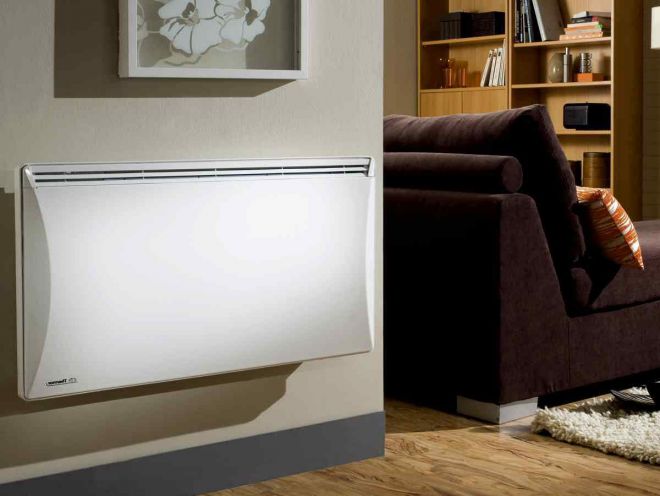

Electric floor convector
Often, people try to have several alternative heat sources in an apartment, allowing them to heat a separate room and depend less on the city boiler house. Portable floor units with wheels are ideal for this purpose. There are universal economical electric convectors for home heating, which, if desired, are used both in the wall and in the floor version. To make the transformation, you need to purchase a set of sturdy interchangeable legs.
Disadvantages of the floor convector:
- obligatory presence of a long power cable,
- removable legs prevent the device from moving close to the wall.
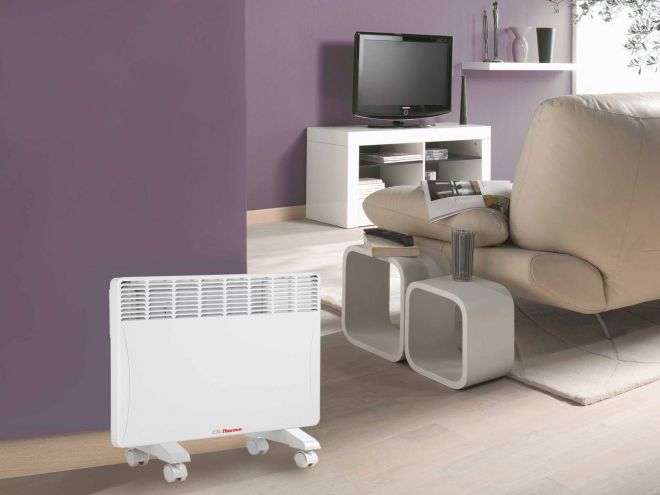

Electric convector built into the floor
Increasingly, in private houses with panoramic windows and a large living area, built-in electric heaters are being installed. It is advisable to install the skirting electric convector in rooms with timber frame floors that are incapable of storing thermal energy. Niches for these devices are designed in advance, providing free space in the floors for a protective box and power cables. Built-in convectors can be hidden under decorative grilles, panels, skirting boards, in window sills or frame furniture supports.
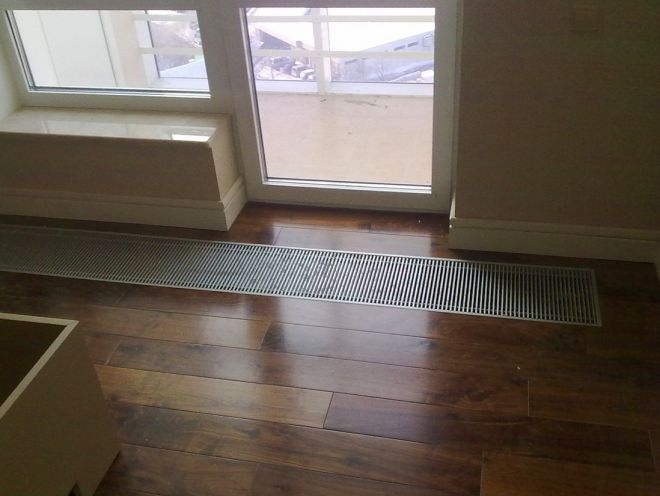

Electric convector with fan
Natural air circulation is slow; to speed up the heating of the room, it is better to use devices equipped with additional compact fans. The insignificant difference in cost and energy consumption more than pays off during operation, because the living room heats up many times faster.Electric convectors for summer cottages with fans have another advantage - forced airflow reduces the thermal load on the casing, increasing the life of the device.
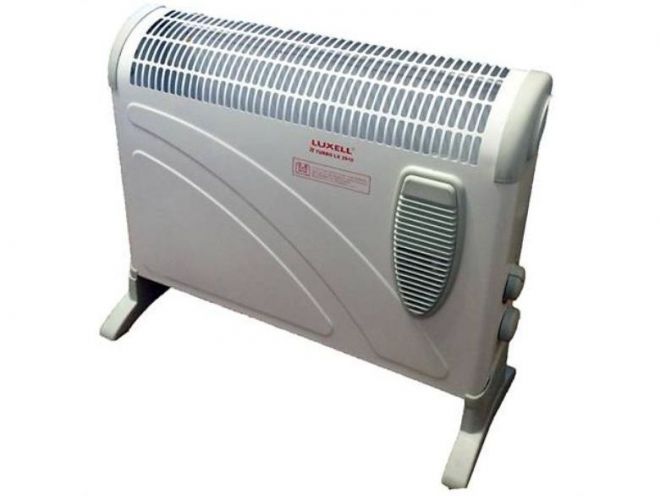

Electric convectors with remote control
Increasingly, people are trying to install not simple devices of the old type with manual control, but equipment equipped with special control units that work with the precision of a clockwork even in the absence of the owner. Electric heating convectors with an electronic thermostat know how to maintain the minimum temperature in the room when it is necessary to raise it to a comfortable level.
The economical electric convectors NOBO, equipped with two types of control systems, have become famous. The ORION 700 system can carry out the weekly programs entered into the device or adjust the heater operation via the GSM module, receiving signals from the owner, issued using a mobile phone. The Energy Control system, which allows a person to connect to the convector via the Internet, is of great interest. With the help of this new item, you get complete information from the sensors about the current situation in your home.
